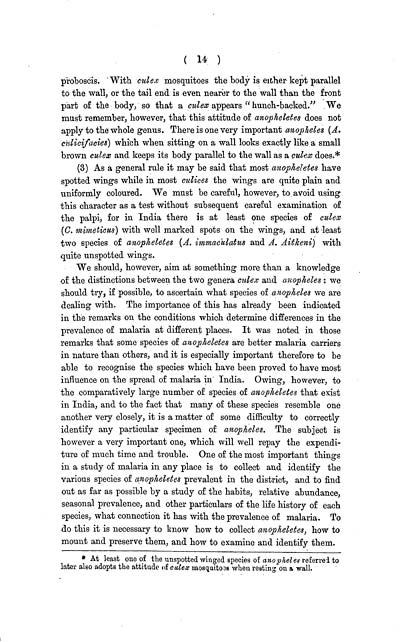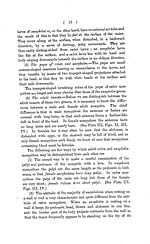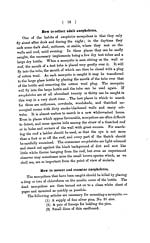Medicine - Disease > Causation and prevention of malarial fevers: a statement of the results of researches drawn up for the use of assistant surgeons, hospital assistants and students
(21) Page 14
Download files
Individual page:
Thumbnail gallery: Grid view | List view

(14)
proboscis. With culex mosquitoes the body is either kept parallel
to the wall, or the tail end is even nearer to the wall than the front
part of the body, so that a culex appears "hunch-backed." We
must remember, however, that this attitude of anopheletes does not
apply to the whole genus. There is one very important anopheles (A.
culicifacies) which when sitting on a wall looks exactly like a small
brown culex and keeps its body parallel to the wall as a culex does.*
(3) As a general rule it may be said that most anopheletes have
spotted wings while in most culices the wings are quite plain and
uniformly coloured. We must be careful, however, to avoid using
this character as a test without subsequent careful examination of
the palpi, for in India there is at least one species of culex
(C. mimeticus) with well marked spots on the wings, and at least
two species of anopheletes (A. immaculatus and A. Aitkeni) with
quite unspotted wings.
We should, however, aim at something more than a knowledge
of the distinctions between the two genera culex and anopheles: we
should try, if possible, to ascertain what species of anopheles we are
dealing with. The importance of this has already been indicated
in the remarks on the conditions which determine differences in the
prevalence of malaria at different places. It was noted in those
remarks that some species of anopheletes are better malaria carriers
in nature than others, and it is especially important therefore to be
able to recognise the species which have been proved to have most
influence on the spread of malaria in India. Owing, however, to
the comparatively large number of species of anopheletes that exist
in India, and to the fact that many of these species resemble one
another very closely, it is a matter of some difficulty to correctly
identify any particular specimen of anopheles. The subject is
however a very important one, which will well repay the expendi-
ture of much time and trouble. One of the most important things
in a study of malaria in any place is to collect and identify the
various species of anopheletes prevalent in the district, and to find
out as far as possible by a study of the habits, relative abundance,
seasonal prevalence, and other particulars of the life history of each
species, what connection it has with the prevalence of malaria. To
do this it is necessary to know how to collect anopheletes, how to
mount and preserve them, and how to examine and identify them.
* At least one of the unspotted winged species of anopheles referred to
later also adopts the attitude of culex mosquitoes when resting on a wall.
proboscis. With culex mosquitoes the body is either kept parallel
to the wall, or the tail end is even nearer to the wall than the front
part of the body, so that a culex appears "hunch-backed." We
must remember, however, that this attitude of anopheletes does not
apply to the whole genus. There is one very important anopheles (A.
culicifacies) which when sitting on a wall looks exactly like a small
brown culex and keeps its body parallel to the wall as a culex does.*
(3) As a general rule it may be said that most anopheletes have
spotted wings while in most culices the wings are quite plain and
uniformly coloured. We must be careful, however, to avoid using
this character as a test without subsequent careful examination of
the palpi, for in India there is at least one species of culex
(C. mimeticus) with well marked spots on the wings, and at least
two species of anopheletes (A. immaculatus and A. Aitkeni) with
quite unspotted wings.
We should, however, aim at something more than a knowledge
of the distinctions between the two genera culex and anopheles: we
should try, if possible, to ascertain what species of anopheles we are
dealing with. The importance of this has already been indicated
in the remarks on the conditions which determine differences in the
prevalence of malaria at different places. It was noted in those
remarks that some species of anopheletes are better malaria carriers
in nature than others, and it is especially important therefore to be
able to recognise the species which have been proved to have most
influence on the spread of malaria in India. Owing, however, to
the comparatively large number of species of anopheletes that exist
in India, and to the fact that many of these species resemble one
another very closely, it is a matter of some difficulty to correctly
identify any particular specimen of anopheles. The subject is
however a very important one, which will well repay the expendi-
ture of much time and trouble. One of the most important things
in a study of malaria in any place is to collect and identify the
various species of anopheletes prevalent in the district, and to find
out as far as possible by a study of the habits, relative abundance,
seasonal prevalence, and other particulars of the life history of each
species, what connection it has with the prevalence of malaria. To
do this it is necessary to know how to collect anopheletes, how to
mount and preserve them, and how to examine and identify them.
* At least one of the unspotted winged species of anopheles referred to
later also adopts the attitude of culex mosquitoes when resting on a wall.
Set display mode to: Large image | Zoom image | Transcription
Images and transcriptions on this page, including medium image downloads, may be used under the Creative Commons Attribution 4.0 International Licence unless otherwise stated. ![]()
| Permanent URL | https://digital.nls.uk/74587100 |
|---|




